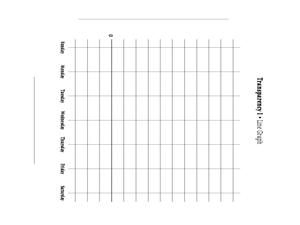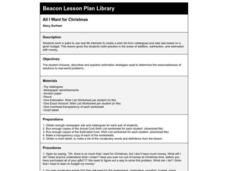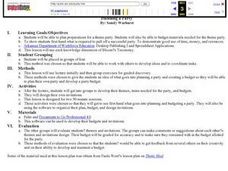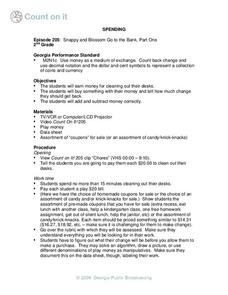Curated OER
Home is the Place
Students apply the concepts of computation, area/perimeter; maximum/minimum; percentage; statistics; and scale drawings to a real world situation. They plan their dream home within a given set of constraints such as budget and zoning.
Curated OER
Less Than Zero
Students keep track of money. In this money management lesson, students read Less Than Zero by Stuart J. Murphy and manipulate a number line to keep track of spending and borrowing in the story.
Curated OER
Money, Money, Honey Bunny!
Students determine the differences between goods and services, and saving and spending. In this economics lesson, students listen to a rhyming story about a bunny with money. They play a matching game with the associated cards and work...
DiscoverE
Build a Bridge
Cost overruns are unacceptable—in the real world and in an engaging activity. Groups of pupils get together to build a bridge out of straws, paper cups, and tape. They keep track of costs ($1,000 for each material) and must stay within a...
Visa
Allowances and Spending Plans
Help youngsters understand how to manage small amounts of money by discussing an allowance and the difference between spending, saving, and giving.
District 158
Plan an Adventure
For kids, taking a vacation is all fun and games, but after completing this pre-algebra project, they'll have a whole new appreciation for the planning that makes these trips possible. Given a budget of $5,000 to spend on purchasing the...
Learning to Give
Five Thousand Dollars!
How does consumerism affect global poverty? Upper graders find out about cost benefit, wants and needs, and making good consumer choices as they explore this global topic. They role-play an impulse spending experience and work through...
Workforce Solutions
Reality Check
Scholars complete the Reality Chech handout that identifies their potential salary given a specific profession. Pupils examine the lifestyle options and choose what they wish to have; however, each item costs money and, depending on how...
Curated OER
Money and health
Students write a proposal with an appropriate budget to establish a health day at school. They design this day to educate and promote good health. They educate other students about health care, inform students of health concerns, and...
Curated OER
Money & Work
Students explain basic information concerning financial investments. They identify consumer rights and responsibilities and effective practices for purchasing consumer goods, services, housing and insurance. They list steps in setting...
Curated OER
The Hundred Penny Box
Students compare how people save money in financial institutions, after reading the story, The Hundred Penny Box. They analyze the advantages of regular saving and how savings grow with compounding.
Curated OER
The Fairfax County Budget -- A Look At Spending
Middle schoolers brainstorm a list of items that should be a priority for the government to help its citizens. Using an out of date budget, they identify individual line items and the conflicts involved in making a budget work. They...
Curated OER
Budget: Don't Go Broke (NEFE)
Pupils examine how to plan and maintain a balanced budget. In this financial literacy activity, teacher students follow the PowerPoint and answer questions based on learned information in order to understand where their money goes and...
EngageNY
Ratios of Fractions and Their Unit Rates 2
Remodeling projects require more than just a good design — they involve complex fractions, too. To determine whether a tiling project will fit within a given budget pupils calculate the square footage to determine the number of tiles...
Curated OER
Building Budgets
Students explore New York City's bid to host the 2012 Olympic Games. They estimate budget allocations for such a proposal while practicing the calculation of percentages.
Curated OER
The Hundred Penny Box
Students analyze the advantages of regular saving and how savings grow with compounding. After reading the story "The Hundred Penny Box", students define the terms "interest," "interest rate," and "compounding." Through several...
Curated OER
Making a Grocery List
Student examine the benefits of making grocery lists. In this family budgeting lesson, young scholars participate in an activity that requires them to create grocery lists for selected meals that families may share.
Curated OER
Navigating Around the United States
Middle schoolers calculate mileage and determine how long a trip take and what stops are necessary as they plan a vacation within the United States. They take money, food, lodging and gas into account for budgeting purposes.
Curated OER
Four Dollars and Fifty Cents
Students role play a scenario between a creditor and debtor. In this consumer education lesson, students read the book Four Dollars and Fifty Cents, discuss the vocabulary introduced in the book and role play a situation between a...
Curated OER
All I Want For Christmas
Fourth graders create wish lists from catalogues and sales ads based on a given budget. They add, subtract, estimate, and budget their given amount of money so they don't go over budget.
Curated OER
Planning a Party
Students, in groups, plan a theme party. They design their own invitations, budget materials needed and demonstrate good use of time, money, and resources.
Curated OER
Wealth of Wisdom
Students determine what to do with money. In this personal finance lesson, students discuss budgeting, savings, and loans with their instructor. Students then participate in classroom activities that require them to participate in...
Curated OER
Money Management
Pupils explore money management skills and economics thru a creative project where students earn "money" for their assigned "jobs." They keep track of their income and expenses in a transaction record and explore the Excel money...
Curated OER
Spending
Student explore the value of money. In this addition and subtraction instructional activity, 2nd graders earn "money" for classroom jobs and spend it in the classroom. Students practice how to add prices and calculate change. This...

























